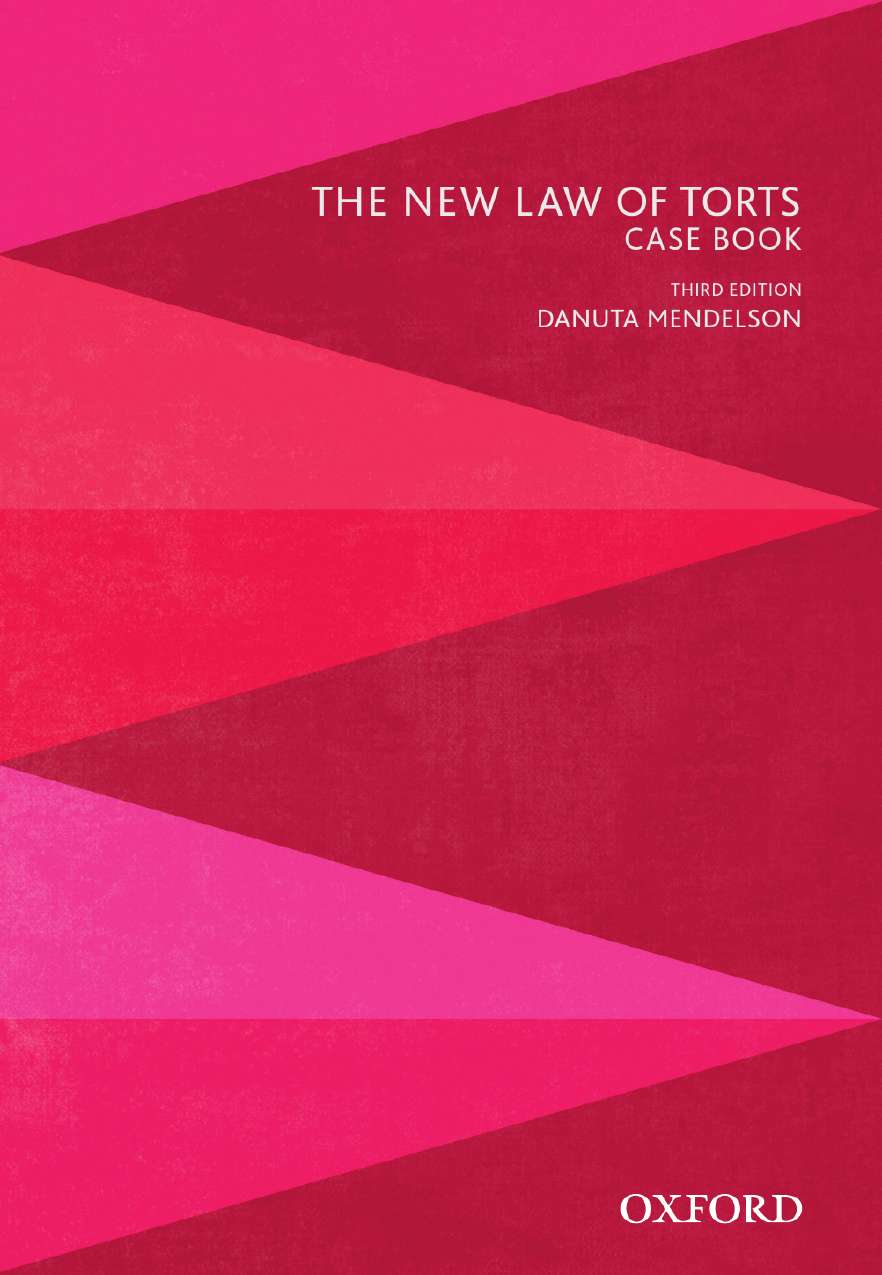PART I: INTRODUCTION
1. Introduction to the Law of Torts and Historical Overview
1.1 Definition and classification of torts
1.2 Historical origins of the law of torts
1.3 Interpretation and construction of legislative provisions
1.4 Torts Reforms of 2002–03
2. Damages
2.1 Introduction
2.2 History of compensation in the law of torts
2.3 Nature of compensation in the law of torts
2.4 Classification of damages
2.5 Special and general (compensatory) damages
2.6 General damages
2.7 Non-economic loss
2.8 Damages for gratuitous services and attendant care
2.9 Punitive (exemplary) damages
3. Survival Actions and Wrongful Death; Statutory Compensation Schemes
3.1 Survival of causes of action
3.2 Wrongful death
3.3 Statutory compensation schemes
PART II: INTENTIONAL TORTS
4. Trespass to the Person (Battery and Negligent Trespass; Assault and False Imprisonment)
4.1 Historical origins of the tort of trespass to the person
4.2 The tort of battery
4.3 Negligent trespass
4.4 The tort of assault
4.5 The tort of false imprisonment
5. Trespass to Land
5.1 Trespass to land: history and rationale
5.2 Elements of the tort of trespass to land
5.3 Trespass beneath and above the surface of the land
5.4 Damages
5.5 Limitations of the tort of trespass to land
5.6 Tort of trespass to land and the right to privacy
6. Miscellaneous Intentional Torts of Action on the Case for Personal Injury
6.1 Origins of action on the Case
6.2 Action on the Case for intentional infliction of physical harm
6.3 Cause of action for intentional infliction of nervous shock
6.4 Malicious prosecution
6.5 Tort of collateral abuse of process
6.6 Misfeasance in public office
6.7 Tort of breach of confidence and misuse of private information
7. Deceit and Injurious Falsehood
7.1 Introduction
7.2 Deceit
7.3 Injurious falsehood
8. Torts of Intentional Interference with Goods or Personal Property
8.1 Introduction
8.2 Trespass to goods (chattels)
8.3 Detinue
8.4 Conversion
8.5 Special action on the Case for intentional damage to goods
8.6 ‘Spoliation’: intentional or negligent destruction of evidence
9. Defences to Intentional Torts
9.1 Introduction
9.2 The concept of fault in intentional torts
9.3 Consent in intentional torts
9.4 Statutory defences of legal authority
9.5 Defences to battery
9.6 Defences to false imprisonment
9.7 Exceptions and defences to trespass to land
9.8 Defence of insanity
9.9 Defence of limitation of actions
9.10 Mistake
PART III: THE TORT OF NEGLIGENCE
10. Negligence: Duty of Care
10.1 Introduction
10.2 Special kinds of duties and liabilities
11. Breach of Duty of Care
11.1 Introduction
11.2 Factors that the court must consider when determining the reasonable person’s response to the risk
11.3 Aspects of statutory provisions relevant to the determination of the breach of duty of care
11.4 Specific standards
11.5 The nature of inference in law
12. Causation and Proof of Breach
12.1 Introduction
12.2 Statutory principles of legal causation
12.3 Multifactorial causality at common law
12.4 Exceptions to factual causation at common law and under statute
12.5 Other aspects of causation
13. Remoteness of Damage
13.1 Introduction
13.2 The meaning of ‘reasonable foreseeability’
13.3 The concept and nature of remoteness of damage
13.4 The test for remoteness of damage
PART IV PARTICULAR CATEGORIES OF CASE
14. Pure Nonfeasance (Pure Omissions)
14.1 Historical introduction: acts and pure omissions
14.2 Pure nonfeasance and the common law
14.3 Liability of public authorities for omissions at common law
14.4 Liability of highway authorities
14.5 Entities vested with regulation making power
15. Mental Harm: Liability for Negligently Occasioned Pure Psychiatric Injury
15.1 Conceptual underpinnings
15.2 The nature of the damage: recognised psychiatric illness
15.3 Consequential nature of the injury
15.4 Statutory paradigm for recovery of damages for negligently caused mental harm
15.5 Evolution of liability for negligently occasioned pure psychiatric injury
15.6 Elements of action for negligently occasioned pure psychiatric injury at common law
16. Pure Economic Loss
16.1 Negligently occasioned pure economic loss
16.2 Negligent misstatement
16.3 Causation and the doctrine of vulnerability
16.4 Remoteness of damage
PART V: DEFENCES TO NEGLIGENCE
17. Defences to Negligence
17.1 Introduction
17.2 Historical background
17.3 Contributory negligence
17.4 Assessment of damages
17.5 Voluntary assumption of risk
17.6 Defence of joint illegal enterprise and the nature of illegality
PART VI: STRICT-LIABILITY TORTS
18. Public and Private Nuisance
18.1 Introduction
18.2 Legal species of nuisance
18.3 Tort of private nuisance
18.4 Interference with the use and enjoyment of property rights
18.5 Activities that offend sensibilities of neighbouring occupiers
18.6 Title to sue
18.7 Who may be sued?
18.8 Remedies
18.9 Defences
19. Breach of Statutory Duty
19.1 Historical introduction
19.2 Nature of private action for breach of statutory duty
19.3 Elements of the action for breach of the statutory duty
19.4 Defences
20. Vicarious Liability and Non-delegable Duty of Care: Types of Liability
20.1 Part 1: Introduction
20.2 Vicarious liability
20.3 Part II: Non-delegable duty of care
20.4 Non-delegable duty of care and vicarious liability
20.5 Part III: Solidary and proportionate liability
PART VII: DEFAMATION
21. Establishing Defamation
21.1 Introduction
21.2 Abolition of the distinction between libel and slander
21.3 Cause of action for publication of defamatory matter
21.4 Elements of the cause of action
21.5 Element 1: The matter conveys a defamatory meanings (imputations)
21.6 Element 2: The matter identifies, or is capable of identifying, the plaintiff as the person defamed
21.7 Element 3: The matter has been published by the defendant to at least one person other than the plaintiff
21.8 Procedural matters
22. Defences and Remedies in Defamation Law
22.1 Introduction to defences
22.2 Justification
22.3 Statutory defence of contextual truth
22.4 Honest opinion
22.5 Absolute privilege
22.6 Public documents
22.7 Reports of proceedings of public concern
22.8 Common law qualified privilege
22.9 Statutory qualified privilege
22.10 Triviality
22.11 The effect of an apology on liability
22.12 Remedies
22.13 Limitation periods
22.14 Offers to make amends




